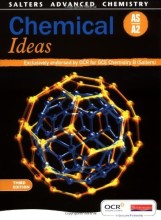Try our study magic for free
Summary: Chemical Ideas | 9780435631499 | central Chris Otter
- This + 400k other summaries
- A unique study and practice tool
- Never study anything twice again
- Get the grades you hope for
- 100% sure, 100% understanding
a PDF, study it super fast
- No sign up, email or credit card needed!
- AI makes unlimited flashcards
- Get unlimited quizzes and tests
- Ask AI anything
- No sign up, email or credit card needed!
- Have and keep perfect overview
- Make flashcards, notes and mind maps
- Review, test and score!
Read the summary and the most important questions on Chemical ideas | 9780435631499 | central team: Chris Otter ...
-
1 Agriculture and Industry
This is a preview. There are 1 more flashcards available for chapter 1
Show more cards here -
How do you calculate the atom economy?
(Mr of useful product/ Mr of reactants) x 100
-
1.1 Green chemical process
This is a preview. There are 5 more flashcards available for chapter 1.1
Show more cards here -
What are potential benefits of using a certain industrial method?
- high percentage yield
- solvent can be recycled = does not damage the environment through waste disposal
- no toxic products
- high atom economy
-
How can chemists help farmers improve food?
- pesticides
- control soil pH
-
Suggest two reasons why CO isn't released into the atmosphere?
- it's toxic
- it can be burnt as a fuel
-
What are the environmental hazards of making benzophenone?
- HCl is produced = toxic
- aluminium compounds are wasted
- benzene is toxic and hazardess
-
What are the benefits of recycling?
- minimise waste
- reduce energy consumption
- reduce feedstock consumption
-
What difficulties arise when recycling plastics?
Sorting different types of plastics as they have similar properties. As a result, most recycled plastics are mixtures of different polymers.
-
Why does recycling aluminium mean a large saving of emitted carbon dioxide compared to other materials e.g. glass?
The process of extracting aluminium consumes a large amount of energy which is produced from burning fossil fuels. Less fuel is needed to recycle aluminium.
-
What hazard arises when using sodamide? How is it minimised?
Reacts violently with water
Keep under anhydrous conditions
-
What hazard arises when using pyridine? How is it minimised?
Highly flammable
Keep in a sealed container & incinerate excess gas
- Higher grades + faster learning
- Never study anything twice
- 100% sure, 100% understanding
Topics related to Summary: Chemical Ideas
-
Agriculture and Industry - Green chemical process
-
Agriculture and Industry - Bonding, structure and properties
-
Agriculture and Industry - Equilibria and concentrations
-
Agriculture and Industry - Equilibrium, rates and industry
-
Agriculture and Industry - Nitrogen chemistry
-
Oceans - Energy, entropy and equilibium
-
Oceans - Energy changes and solutions
-
Oceans - Acid-base equilibria and pH
-
Oceans - Buffer solutions
-
Oceans - Hydrogen bonding and water
-
Medicines by Design - Organic reactions
-
Medicines by Design - Planning a synthesis
-
Medicines by Design - n.m.r
-
Colour by Design - Oils and fats
-
Colour by Design - Ultraviolet and visible spectroscopy
-
Colour by Design - Gas-liquid chromatography
-
Colour by Design - Arenes
-
Colour by Design - Reactions of arenes
-
Colour by Design - Azo dyes
-
Colour by Design - Chemistry of colour
































